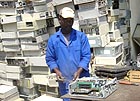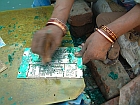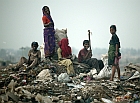Verschwendung wertvoller Ressourcen: «Elektroschrott» wird häufig verbrannt anstatt rezykliert
UN-Initiative zur Verbesserung des Elektroschrott-Recycling angelaufen

| Mit jedem Produkt mit einer Batterie oder einem Stecker, das wir auf den Müll werfen – Computer, Fernseher, Radios, Handys, MP3-Player, um nur einige zu nennen –, vergeuden wir wertvolle Ressourcen. Der Elektroschrottberg wächst weltweit in einem ungeheuren Tempo. Ausserdem werden gebrauchte Elektrogeräte, die in Entwicklungsländer verschickt werden, dort häufig nicht wieder in Gebrauch genommen, sondern illegal entsorgt – meist durch Verbrennen, was nicht nur die wieder verwertbaren Komponenten unwiederbringlich zerstört, sondern auch erheblich zur Umweltverschmutzung in diesen Ländern beiträgt. «In diesen Elektroschrottbergen liegt weit mehr als nur Gold vergraben», sagt der UNU-Forscher Rüdiger Kühr. «Die internationale StEP-Partnerschaft setzt sich dafür ein, diese zunehmend wertvollen Ressourcen wiederzuverwerten und damit zu verhindern, dass sie die Umwelt verschmutzen.» | |||
| Neben Edelmetallen wie Gold, Palladium und Silber spielen seltene Elemente eine immer wichtigere Rolle bei der Herstellung elektronischer Bauteile. Beispielsweise Indium, ein Nebenprodukt des Zinkabbaus, das jährlich in mehr als einer Milliarde Elektroprodukten wie Flachbildschirme und Handys verwendet wird. | ||
| In den letzten fünf Jahren ist der Indiumpreis am Weltmarkt um das Sechsfache gestiegen – inzwischen ist es teurer als Silber. Obwohl die Indiumvorräte langsam zur Neige gehen, wird das seltene Metall nur in wenigen Fabriken in den USA, Belgien und Japan rezykliert. Dabei nimmt Japan eine Art Vorreiterrolle ein; das Land deckt rund die Hälfte seines Indiumbedarfs durch Recycling. Doch Indium ist kein Einzelfall; auch Wismut, das in bleifreien Loten zum Einsatz kommt, ist heute doppelt so teuer wie noch 2005. Und der Preis für Ruthenium, verwendet in Festplattenlaufwerken und elektrischen Widerständen, ist gar um das Siebenfache gestiegen – in nur einem Jahr. «Der teils massive Preisanstieg führt uns vor Augen, dass unsere Versorgung mit diesen seltenen Elemente nicht auf ewig sichergestellt ist – es sei denn, wir etablieren endlich gut funktionierende Recyclingverfahren, um sie aus alten Produkten zurückzugewinnen», so Kühr. | |||
| Vielfältige Umwelt- und Gesundheitsbelastungen durch unsachgemässes Elektroschrott-Recycling Es ist allerdings nicht nur die Ressourcenknappheit, die ein Recycling der wertvollen Rohstoffe unumgänglich macht. Ein unsachgemässer und gewissenloser Umgang mit Elektroschrott verursacht unzählige Umwelt- und Gesundheitsprobleme. | ||
| Dazu gehören die extrem giftigen Dioxine, Furane und polyzyklischen aromatischen Kohlenwasserstoffe (PAKs), die beim Verbrennen von PVC-Kunststoffen entstehen, aber auch Boden- und Wasserverschmutzung durch bromierte Flammschutzmittel (aus Platinen, Computergehäusen und Kabeln), polychlorierte Biphenyle (PCB; in Transformatoren und Kondensatoren) sowie durch Blei, Quecksilber, Kadmium, Chrom und andere Schwermetalle (unter anderem aus Bildschirmen). Studien haben gezeigt, dass die Bevölkerung immer stärker belastet ist mit diesen Schwermetallen, die zu Fehlentwicklungen des Nervensystems und zu Krebs führen können. In vielen Schwellen- und Entwicklungsländern leben immer mehr Menschen vom Elektroschrott-Recycling. Meist findet dies in so genannten «Hinterhofwerkstätten» statt, wobei die Arbeiter – Männer, Frauen, Kinder – erheblichen Gesundheitsgefahren ausgesetzt sind. Ein weltweit verbindlicher Leitfaden zum Zerlegen von Elektroschrott und zur Maximierung der Recycling-Erträge ist eines der vorrangigsten StEP-Ziele. Ein Projekt, das beispielsweise China helfen soll, den einheimischen Elektroschrott sicher aufzubereiten und zu entsorgen, ist bereits angelaufen. | |||
| StEP geht auf einen Vorstoss der UNU, des UN-Umweltprogramms (UNEP) und der UN-Welthandels- und Entwicklungskonferenz (UNCTAD) zurück. Verschiedene Arbeitsgruppen beschäftigen sich mit Themen wie der Verlängerung der Lebensdauer von Elektroprodukten und deren Wiederverwendung sowie dem Aufbau der entsprechenden Infrastruktur und des Know-hows in den betroffenen Ländern. Die Empa-Abteilung «Technologie und Gesellschaft», die bereits seit mehr als drei Jahren im Auftrag des SECO im Programm «Wissenspartnerschaften im E-Schrott-Recycling» in Ländern wie Indien, China und Südafrika tätig ist, übernimmt dabei die Leitung der Arbeitsgruppe «Recycling». «StEP erlaubt es uns und unseren Partnern, dringende Forschungsprojekte anzustossen und zu finanzieren. Gerade erst hat eine Studentin an der Empa ihre Diplomarbeit erfolgreich abgeschlossen, die sich mit der Rückgewinnungseffizienz von Gold aus Computerplatinen durch «Hinterhof»-Recycling im indischen Bangalore beschäftigte», sagt Rolf Widmer, Empa-Forscher und Leiter der StEP-Arbeitsgruppe «Recycling». Diese Arbeit sei nur möglich gewesen dank der Zusammenarbeit verschiedener StEP-Mitglieder, insbesondere der Industriepartner. «Genau deshalb haben wir vor zweieinhalb Jahren aktiv mitgewirkt, StEP aus der Taufe zu heben», so Widmer. | |||
| Die jährliche Menge Elektroschrott füllt eine Schlange von Müllwagen, die um die halbe Erde reicht Elektroschrott ist einer der am schnellsten anwachsenden Teile des weltweiten Müllberges – und gleichzeitig einer der bedenklichsten. Die europäische Umweltbehörde hat berechnet, dass die Menge an Elektroschrott – jährlich nahezu 40 Millionen Tonnen – rund dreimal schneller wächst als jede andere Art von Hausmüll. | ||
| Füllt man den jährlich weltweit anfallenden Elektroschrott in Müllwagen, ergäbe dies eine Schlange, die sich um den halben Erdball erstreckt. Immer kürzere Produktezyklen – vor allem in der Informations- und Kommunikationstechnologie (ICT) – lassen den Elektroschrottberg immer rasanter anwachsen. Zahlen der Organisation für wirtschaftliche Zusammenarbeit und Entwicklung (OECD) ergeben für den globalen ICT-Handel im Jahr 2004 einen Umsatz von rund 2.2 Billionen Franken; das sind 2.2 Millionen Millionen und entspricht 7.7 Prozent des globalen Bruttosozialprodukts. Im Jahr 2004 stand in jedem zweiten deutschen Haushalt ein PC, Ende 2006 waren bereits 75 Prozent aller deutschen Haushalte damit ausgerüstet. Japan ist ähnlich gut mit PCs versorgt, im Gegensatz zu 0.07 Prozent aller Haushalte in Niger, 1.2 Prozent in Indien, 2.3 Prozent in Bolivien und 4.1 Prozent in China. Das Wachstumspotenzial für Elektrogeräte ist also – vor allem in Entwicklungs- und Schwellenländern – enorm; die Elektroschottberge dürften sich dadurch kaum verringern. Die Herstellung eines PC verbraucht 1.8 Tonnen an Rohstoffen Eine längere Lebensdauer und die vermehrte Wiederbenutzung von Elektrogeräten würden auch helfen, die bei der Herstellung anfallenden Umweltbelastungen zu verringern. Das 2004 von der UNU herausgegebene Buch «Computers and the Environment» kam zu dem Schluss, dass der Durchschnitts-PC inklusive Bildschirm bei seiner Herstellung rund das Zehnfache seines Gewichts an fossilen Energieträgern verbraucht. Zum Vergleich: Die Produktion eines Autos oder eines Kühlschranks verbraucht gerade mal das Ein- bis Zweifache des Produktgewichts. Konkret heisst das: Die Herstellung eines PC mit 17-Inch-Bildschirm benötigt 240 Kilogramm fossile Energieträger, 22 Kilogramm Chemikalien und 1500 Kilogramm Wasser – insgesamt also 1.8 Tonnen Rohstoffe, soviel wie ein SUV oder ein Nashorn. «Es ist klar, dass wir die mit dem ständigen Anwachsen des Elektroschrotts verbundenen Probleme der Ressourcenknappheit sowie der Umwelt- und Gesundheitsbelastung jetzt anpacken müssen», sagt der Rektor der UNU, Hans van Ginkel. Von der StEP-Initiative würden letztlich alle profitieren, ist er überzeugt. «Unternehmen, die sich an StEP beteiligen, profitieren durch weltweit einheitliche, sichere und umweltfreundliche Recycling- und Entsorgungsverfahren für Elektroschrott. Ausserdem sollten sich gemäss StEP-Richtlinien ihre Produkte in Zukunft leichter aufrüsten lassen. Denn ein nagelneues Produkt zu kaufen, wenn eigentlich nur eine Komponente davon aufgerüstet werden sollte, ist äusserst verschwenderisch. Und die Konsumentinnen und Konsumenten profitieren, weil sie nun einerseits Elektroprodukte mit längerer Lebensdauer erhalten, andererseits weil sie wissen, was sie mit ihren ausrangierten Produkten anfangen sollen», so van Ginkel. Das StEP-Logo auf Elektroprodukten soll in Zukunft signalisieren, dass der Hersteller in punkto Elektroschrott-Verwertung internationalen «Best practice»-Richtlinien genügt.
Redaktion: | |||
| ||||
| ||||



